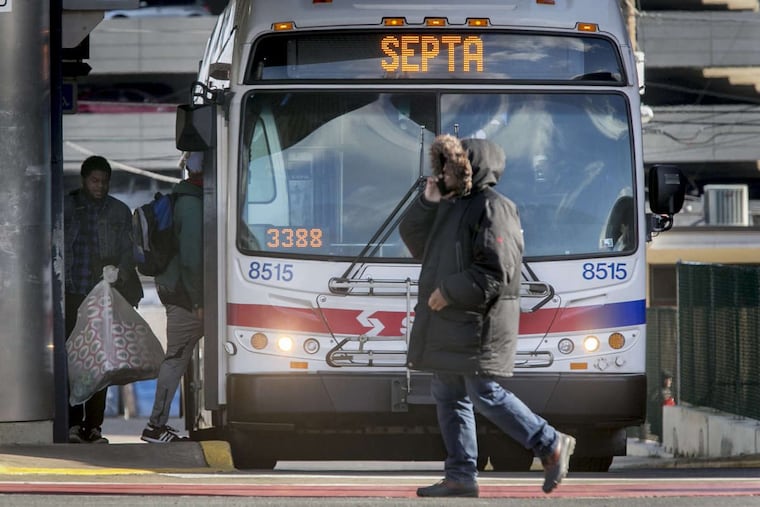Cars are blocking bus stops everywhere in Philly. The PPA has a simple fix
Cameras already installed on SEPTA's buses could be the key to stopping vehicles from illegally parking in bus stops.

A solution to parking violations that hold up traffic and put people at risk could already be on the streets: the cameras mounted on SEPTA's buses.
The Philadelphia Parking Authority is now exploring the possibility of using those cameras to keep people from parking in bus stops, the authority's new executive director said. Officials estimated that up to 2,000 times a day a vehicle blocks a bus stop in the city.
"You want to curb that behavior," said Scott Petri, who became the PPA's executive director at the beginning of the year. "You want it to drop dramatically."
SEPTA's review of the buses' forward-facing cameras showed lots of bus stops blocked by delivery trucks, ride-share pickups, or cars stopped while drivers run errands.
"Just reviewing our cameras showed loads of parking violations in bus zones," said Frank Kelly, SEPTA's assistant general manager for government affairs.
If more aggressively enforced, the number of violations could initially generate tens of millions of dollars in revenue for the PPA, officials there projected.
Blocking the bus stop, SEPTA officials said, creates problems for passengers who are unable to step into the vehicle, such as people in wheelchairs, because the bus cannot pull against the curb. And it's less safe for passengers to get off a bus into the street, rather than onto the curb, too, SEPTA officials said.
Blocking bus stops also worsens traffic problems. A bus that has to stop and unload people in the middle of a lane can bring traffic to a near standstill even on roads with multiple travel lanes.
"Traffic is like a funnel," said Erik Johanson, SEPTA's director of business innovation. "If something blocks a part of the funnel, the water's going to flow slower."
The congestion and unsafe conditions created by buses with nowhere to stop has a spillover effect on the entire neighborhood, said Paul Levy, head of the Center City district.
"It's not just private automobiles and taxis stopping in travel lanes and bus stops, we've added many more delivery trucks, ride-sharing vehicles, and cyclists to downtown streets," he said. "We need to rethink both regulations and enforcement and make sure we have adequate funding in place to maintain both vitality and safety."
SEPTA manages 118 bus routes covered by 1,200 buses. The agency did not have data on accidents or incidents that might have been caused by buses being blocked from reaching the curb, spokesman Andrew Busch said.
The Philadelphia Parking Authority has the authority to enforce bus stop parking violations, but typically only does when enforcement personnel see the violation, Petri said. The idea of using SEPTA's own cameras to improve enforcement is part of an effort Petri has underway to seek ways the PPA can cooperate more with other city street and transportation agencies.
It's not a novel idea. In New York City and San Francisco, cameras on buses photograph the license plates of people blocking bus stops and bus lanes.
Here, bus drivers can use a trigger on the bus to take pictures with the forward-facing camera, Petri said, and those pictures of violators could be sent to the PPA, which would then issue a violation to that license plate.
"It's astounding the number of violations," Petri said after seeing SEPTA video of violations that buses encounter on city streets. "Tickets issued per day would be astounding."
The offense, illegal parking in a bus zone, would net a violator a $76 fine in Center City and $51 everywhere else in the city. While Petri anticipated significant revenue if the PPA is allowed to use bus cameras for ticketing, he expected the money coming in would decline as drivers learned they could not get away with blocking bus stops.
To make it happen, though, would likely require new legislation from Harrisburg to authorize the use of SEPTA's cameras for enforcement, Petri said.
Philadelphia's Office of Transportation and Infrastructure Systems supported the PPA proposal, said Christopher Puchalsky, the office's director of policy and strategic initiatives. Street-level public transportation is routinely blocked by cars, he said, adding the trolley stop he uses was blocked by a parked car Monday morning, "which made both watching for the trolley difficult, and also when I stepped out into the street to see when it was coming."
The city's transportation office has been the point agency in the mayor's Vision Zero program, an effort to eliminate traffic-related deaths in the city by 2030. The agency has been casting a wide net, looking for solutions to the city's traffic safety issues. Vision Zero emphasizes the importance of street design and engineering, but the city has also explored expanded use of red light and speed cameras, and increasing manned traffic enforcement in busy neighborhoods.
Using bus cameras to identify bus zone violators requires drivers to make decisions about when to snap a picture, which raises concerns about ensuring fairness, Puchalsky said. The Vision Zero approach, which originated in Sweden but is being implemented widely in the United States, takes into account the potential enforcement efforts have for discrimination and bias.
"We need to make sure it's done equitably so we're not targeting poor, minority neighborhoods with more enforcement," Puchalsky said.
Among the other ideas Petri discussed with SEPTA was making the transportation agency's Key fare card compatible with the PPA's parking kiosks.